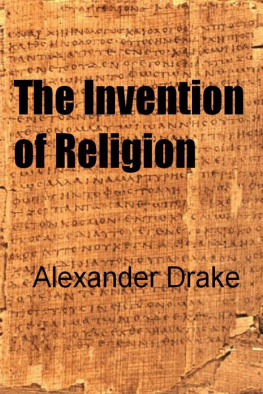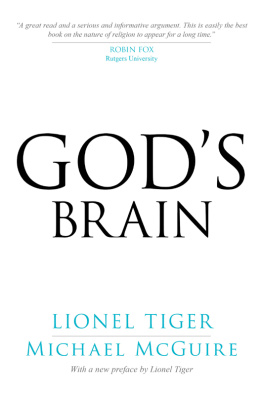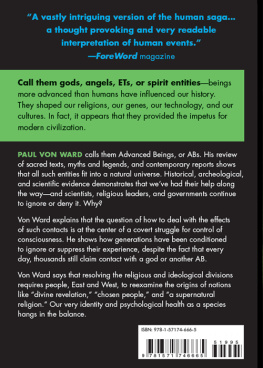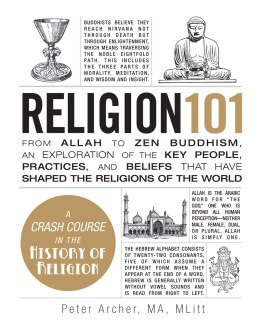The Invention of Religion
Alexander Drake
THE INVENTION OF RELIGION
Copyright 2012 by Alexander Drake
All rights reserved. No part of this book may be reproduced or transmitted in any form or by any means without written permission from the publisher. This is a work of fiction; any resemblance to actual events or persons is entirely coincidental.
Printed on acid-free paper
Cataloging-in-Publication data on file at the Library of Congress
ISBN 978-0-9767923-9-0
The Emperor Has No Clothes Press
Printed in USA
1 3 5 7 9 10 8 6 4 2
A Note on the Text
Part 1 will make very little sense unless it is read in order, beginning with the introduction. So readers are greatly discouraged from skipping around, although the intercalary chapters with headings of On can be read in any order without losing coherence.
Part 2 can be read at any time and in any order.
Part 1
Chapter One
Introduction
This work sets out to prove that, in the absence of knowledge, humans will invent a religion.
Over the course of the book, we will investigate certain psychological phenomena to see what aspects (behaviors, ideas, etc.) they cause in man and then show that four key aspects combine and evolve into what we think of as religion.
We will begin by investigating the psychological phenomena that cause each aspect of a religion to take form, but these will form what we will call the basis of a religion. What this means is that the elements of the basis form the underlying elements of the religion and as time passes and more people are introduced, the religion evolves to include more adaptations (see Chapter Six: The Evolution of Religion).
To show this, we will invent an imaginary Man on an Island who has encountered no religions nor science. Then, through a series of thought experiments, we will see what effect various psychological phenomena will have on him, which will ultimately show us how the key aspects of religions are formed.
Now since we know where we are headed, we will make some definitions ahead of time that agree with our conclusions (for now we are supposing these definitions are accurate and then throughout our investigations we will show that they are accurate). For our purposes, we will define the basis of a religion as any set of beliefs that contains rituals, deities, and an afterlife that includes the concept of a soul . And when these beliefs evolve and are combined with etiological stories, they form a religion.
From our definition of the basis of a religion, we find the four key aspects of a religion, rituals, deities, an afterlife, and souls . We will further define ritual to be a prescribed set of ceremonial behaviors ; a deity to be a being who is worshipped and has authority over certain aspects of life ; souls to be the animating essence of a person that distinguishes them from others ; and an afterlife in which the soul separates from the physical body and survives the death of the body .
Now we also need to make some definitions regarding the Man on an Island. We will call our Man on an Island completely nave , which we will define as having had no prior experience or knowledge. And he is also a normal observer which we will define as being in a state in which all his knowledge comes from his own direct observations and that he would make the same deductions from what he observes as any normal human would (this means that all the psychological mechanisms that we will investigate also apply to him). But we will also say that the Man on an Island is not necessarily one man, but can be lots of men that extend over generations or millennia and share their experiences through language. And we will see how the sharing of experiences through language evolves a religion in Chapter Six: The Evolution of Religion.
The Man on an Island will therefore serve as a model for what humans are like whenever they lack science and religion (or in other words, whenever they exist with an absence of knowledge), which means he also serves as a model for early man. Of course, early man wouldnt necessarily have been completely nave like the Man on an Island, but since we are performing a thought experiment we want an idealized environment so that we can analyze what observations and deductions the Man on an Island would make without any confounding variables.
Throughout the course of this book, the typical method of each chapter will be to present experiments that demonstrate certain psychological phenomena that are related to each key aspect. The reasoning behind this is that, when experiments are performed correctly, they untangle cause and effect relationships.
An easy way to study cause and effect is to deliberately cause a change in a variable (the independent variable ) and measure the effect it has on another variable (the dependent variable ). The way to measure the effects that the independent variable has on the dependent variable is to use a control sample which is identical to the experimental group except that the independent variable is not introduced to it. For example, to test the effect of a drug (the independent variable) on peoples memory (the dependent variable), one randomly selected group would be given the drug (the experimental group) and another equally random group would be given a placebo (the control group); then a memory test would be given to both groups and the scores would be compared between the two groups. And if there is a statistically significant difference (which means that it is unlikely that these results occurred by chance) between the two groups, then the drug has an effect on memory.
In this way, control groups are used to eliminate alternate explanations of the results that come from performing the experiment because they show that the effect on the dependent variable does not happen in the absence of the independent variable. Moreover, controlled experiments establish that the reason for something happening can be directly pinpointed to a cause, such that any time that particular independent variable is introduced, there will be the same effect on the dependent variable.
So we can see that once we have established a cause and effect relationship for a psychological phenomena that is related to one of the key aspects, we will know how this aspect will take form in the Man on an Island and therefore also in early man.
A Note: This doesnt mean that these psychological phenomena are what make people religious, they are what caused early humans to invent religions. For example, someone can still be religious and not think the world is just (see Chapter Five: The Afterlife).
We will proceed with a chapter for each of the four key aspects, followed by a chapter explaining how these aspects evolve into a more cohesive whole. Then we will show that todays major religions could have been formed from the four key aspects. And finally we will examine whether there is evidence that morality and life can originate without the intervention of deities.
Chapter Two
Ritual
A prescribed set of ceremonial behaviors.
This chapter will show that ritualistic behavior is a direct consequence of non-contingent reinforcement . Reinforcement schedules are a feature of operant conditioning . The story commonly associated with conditioning is Pavlov training dogs to salivate at the sound of a metronome; however, that is an example of classical conditioning, which deals with the modification of involuntary behavior. Operant conditioning is the form of conditioning dealing with voluntary behavior.
Dog training is an easily observable form of operant conditioning. The trainer has a desired behavior in mind, like shaking hands, and uses treats to reward that behavior. By rewarding the dogs behavior, the trainer increases the likelihood of that behavior being repeated and if the behavior is paired with an instruction like saying, Shake, or holding out your hand then the dog will learn to follow the instruction with the desired behavior. This is the basic character of operant conditioning: a behavior is rewarded or punished to respectively increase or decrease the likelihood of it happening again ; and an instruction can serve as a discriminative stimulus , which indicates by its presence that the paired behavior will be rewarded.










